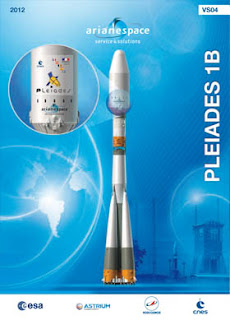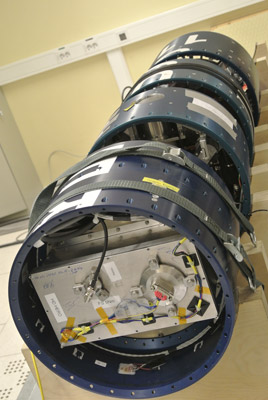ESO - European Southern Observatory logo.
30 November 2012
ALMA sizes up grains of cosmic dust around failed star
Artist’s impression of the disc of dust and gas around a brown dwarf
Astronomers using the Atacama Large Millimeter/submillimeter Array (ALMA) have for the first time found that the outer region of a dusty disc encircling a brown dwarf contains millimetre-sized solid grains like those found in denser discs around newborn stars. The surprising finding challenges theories of how rocky, Earth-scale planets form, and suggests that rocky planets may be even more common in the Universe than expected.
Rocky planets are thought to form through the random collision and sticking together of what are initially microscopic particles in the disc of material around a star. These tiny grains, known as cosmic dust, are similar to very fine soot or sand. However, in the outer regions around a brown dwarf — a star-like object, but one too small to shine brightly like a star — astronomers expected that grains could not grow because the discs were too sparse, and particles would be moving too fast to stick together after colliding. Also, prevailing theories say that any grains that manage to form should move quickly towards the central brown dwarf, disappearing from the outer parts of the disc where they could be detected.
Artist’s impression of grains in the disc around a brown dwarf
“We were completely surprised to find millimetre-sized grains in this thin little disc,” said Luca Ricci of the California Institute of Technology, USA, who led a team of astronomers based in the United States, Europe and Chile. “Solid grains of that size shouldn’t be able to form in the cold outer regions of a disc around a brown dwarf, but it appears that they do. We can’t be sure if a whole rocky planet could develop there, or already has, but we’re seeing the first steps, so we’re going to have to change our assumptions about conditions required for solids to grow,” he said.
The brown dwarf ISO-Oph 102
ALMA’s increased resolution compared to previous telescopes also allowed the team to pinpoint carbon monoxide gas around the brown dwarf — the first time that cold molecular gas has been detected in such a disc. This discovery, and that of the millimetre-size grains, suggest that the disc is much more similar to the ones around young stars than previously expected.
Location of the brown dwarf ISO-Oph 102 in the constellation of Ophiuchus
Ricci and his colleagues made their finding using the partially completed ALMA telescope in the high-altitude Chilean desert. ALMA is a growing collection of high precision, dish-shaped antennas that work together as one large telescope to observe the Universe with groundbreaking detail and sensitivity. ALMA “sees” the Universe in millimetre-wavelength light, which is invisible to human eyes. Construction of ALMA is scheduled to finish in 2013, but astronomers began observing with a partial array of ALMA dishes in 2011.
Wide-field view of the Rho Ophiuchi star-forming region in visible light
The astronomers pointed ALMA at the young brown dwarf ISO-Oph 102, also known as Rho-Oph 102, in the Rho Ophiuchi star-forming region in the constellation of Ophiuchus (The Serpent Bearer). With about 60 times the mass of Jupiter but only 0.06 times that of the Sun, the brown dwarf has too little mass to ignite the thermonuclear reactions by which ordinary stars shine. However, it emits heat released by its slow gravitational contraction and shines with a reddish colour, albeit much less brightly than a star.
The growth of cosmic dust grains in the disc around the brown dwarf ISO-Oph 102
ALMA collected light with wavelengths around a millimetre, emitted by disc material warmed by the brown dwarf. The grains in the disc do not emit much radiation at wavelengths longer than their own size, so a characteristic drop-off in the brightness can be measured at longer wavelengths. ALMA is an ideal instrument for measuring this drop-off and thus for sizing up the grains. The astronomers compared the brightness of the disc at wavelengths of 0.89 mm and 3.2 mm. The drop-off in brightness from 0.89 mm to 3.2 mm was not as steep as expected, showing that at least some of the grains are a millimetre or more in size.
Artist’s impression of grains in the disc around a brown dwarf
“ALMA is a powerful new tool for solving mysteries of planetary system formation,” commented Leonardo Testi from ESO, a member of the research team. “Trying this with previous generation telescopes would have needed almost a month of observing — impossibly long in practice. But, using just a quarter of ALMA's final complement of antennas, we were able to do it in less than one hour!” he said.
The Brown Dwarf ISO-Oph 102
In the near future, the completed ALMA telescope will be powerful enough to make detailed images of the discs around Rho-Oph 102 and other objects. Ricci explained, “We will soon be able to not only detect the presence of small particles in discs, but to map how they are spread across the circumstellar disc and how they interact with the gas that we’ve also detected in the disc. This will help us better understand how planets come to be.”
More information:
This research is presented in a paper in the Astrophysical Journal Letters.
Ricci and Testi worked with Antonella Natta of the INAF-Osservatorio Astrofisico de Arcetri, Aleks Scholz of the Dublin Institute for Advanced Studies, and Itziar de Gregorio-Monsalvo of the Joint ALMA Observatory.
ALMA, an international astronomy facility, is a partnership of Europe, North America and East Asia in cooperation with the Republic of Chile. ALMA construction and operations are led on behalf of Europe by ESO, on behalf of North America by the National Radio Astronomy Observatory (NRAO), and on behalf of East Asia by the National Astronomical Observatory of Japan (NAOJ). The Joint ALMA Observatory (JAO) provides the unified leadership and management of the construction, commissioning and operation of ALMA.
The year 2012 marks the 50th anniversary of the founding of the European Southern Observatory (ESO). ESO is the foremost intergovernmental astronomy organisation in Europe and the world’s most productive ground-based astronomical observatory by far. It is supported by 15 countries: Austria, Belgium, Brazil, the Czech Republic, Denmark, France, Finland, Germany, Italy, the Netherlands, Portugal, Spain, Sweden, Switzerland and the United Kingdom. ESO carries out an ambitious programme focused on the design, construction and operation of powerful ground-based observing facilities enabling astronomers to make important scientific discoveries. ESO also plays a leading role in promoting and organising cooperation in astronomical research. ESO operates three unique world-class observing sites in Chile: La Silla, Paranal and Chajnantor. At Paranal, ESO operates the Very Large Telescope, the world’s most advanced visible-light astronomical observatory and two survey telescopes. VISTA works in the infrared and is the world’s largest survey telescope and the VLT Survey Telescope is the largest telescope designed to exclusively survey the skies in visible light. ESO is the European partner of a revolutionary astronomical telescope ALMA, the largest astronomical project in existence. ESO is currently planning the 39-metre European Extremely Large optical/near-infrared Telescope, the E-ELT, which will become “the world’s biggest eye on the sky”.
Links:
Research paper:
http://www.eso.org/public/archives/releases/sciencepapers/eso1248/eso1248a.pdf More about ALMA at ESO:
http://www.eso.org/public/teles-instr/alma.html The Joint ALMA Observatory:
http://www.almaobservatory.org/Images, Text, Credit: ALMA (ESO/NAOJ/NRAO)/M. Kornmesser (ESO)/L. Calçada (ESO)/Digitized Sky Survey 2. Acknowledgement: Davide De Martin/IAU and Sky & Telescope/Videos: ALMA (ESO/NAOJ/NRAO)/L. Calçada (ESO)/M. Kornmesser (ESO)/Nick Risinger (skysurvey.org)/Digitized Sky Survey 2 Music: movetwo.
Best regards, Orbiter.ch














































.jpg)



